University Audit and Assurance Report: Business Risks Analysis
VerifiedAdded on 2023/03/20
|15
|3782
|81
Report
AI Summary
This comprehensive audit and assurance report meticulously examines the audit risks associated with a business, focusing on key financial ratios, internal control settings, and potential weaknesses within the system. The report analyzes ratios like current ratio, quick ratio, return on equity, return on total assets, gross profit margin, marketing expenses, administrative expenses, and times interest earned ratio, as well as inventory and accounts receivable days. For each ratio, the report identifies potential audit risks and suggests appropriate audit procedures, including tests of detail and internal control assessments. The report highlights weaknesses in inventory internal control and provides corresponding audit procedures to mitigate the associated risks, emphasizing the importance of computerized processes and the need for regular monitoring to ensure accuracy and prevent misstatements in financial reporting.
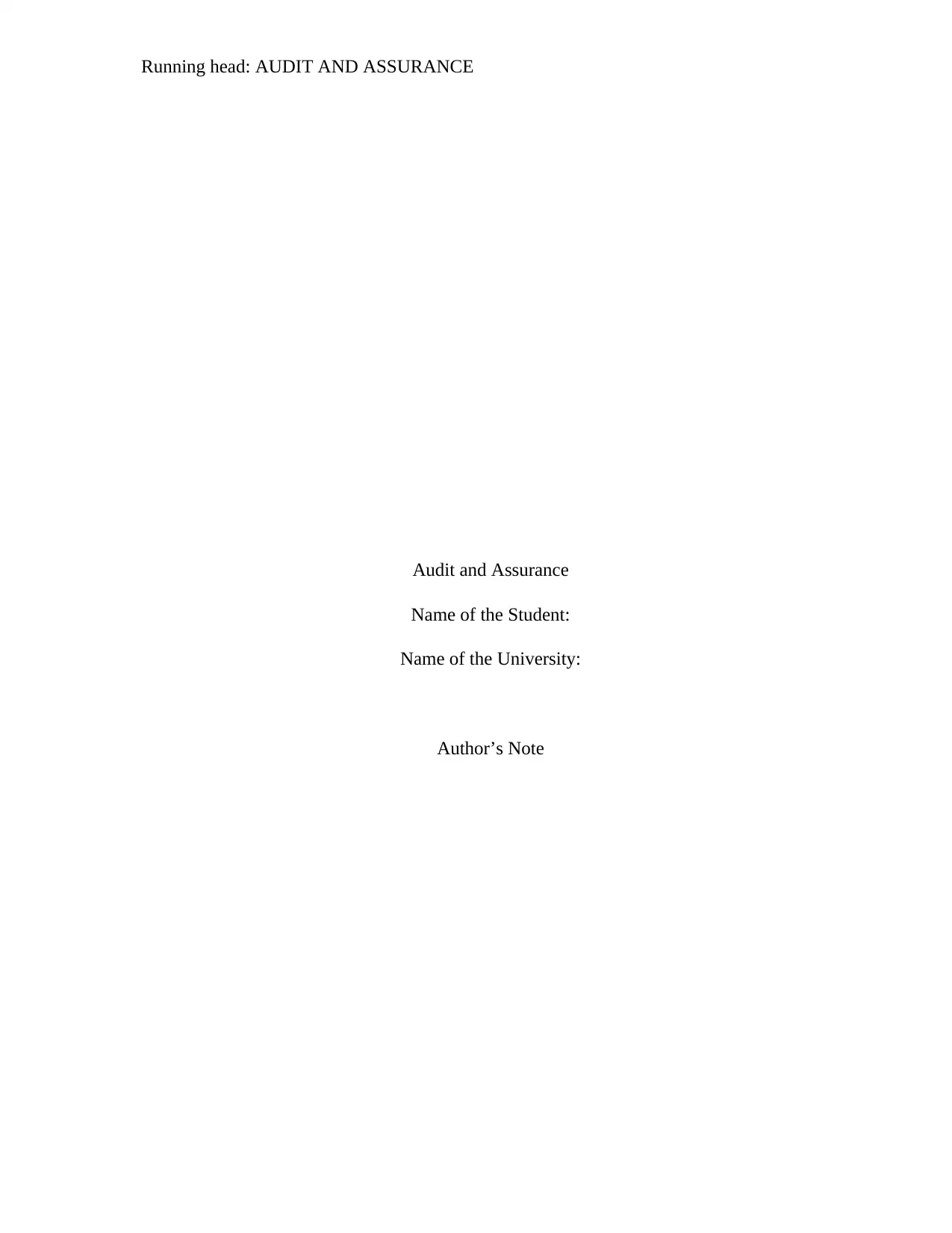
Running head: AUDIT AND ASSURANCE
Audit and Assurance
Name of the Student:
Name of the University:
Author’s Note
Audit and Assurance
Name of the Student:
Name of the University:
Author’s Note
Paraphrase This Document
Need a fresh take? Get an instant paraphrase of this document with our AI Paraphraser

1
AUDIT AND ASSURANCE
Memo
To: Wayne Wiadrowski
From: The Audit Manager
Date: 8th May, 2019
Subject: Audit risks applicable to the business
Purpose and Scope
The main purpose of the memo is to bringing into light the audit risks which is associated with
the business and the same would be assessing the key financial ratios which are considered and
the internal control settings of the business. The memo would be identifying the weaknesses in
the internal control system of the business and the necessary audit procedures which the audit
needs to take for assessing the audit risks of the business.
Ratios Analysis Audit Risks Audit Procedures
Current Ratio The current ratio of
the business is shown
to be more than the
budgeted estimate of
the business but the
same is lower than
industry average.
This indicates that the
current assets of the
business has either
increased or it may be
due to decrease in
current liabilities of
the business.
The audit risk
associated with
current ratio is that
there might be
presence of material
misstatement in the
values which is
portrayed for current
assets or current
liabilities of the
business.
The auditor needs to
apply test of detail
analysis in order to
assess whether the
figures of current
assets and current
liabilities of the
business is showing
true and fair view
(Alles et al.,2018).
The auditor needs to
apply verification
procedures for the
purpose of
understanding the
values of the assets
AUDIT AND ASSURANCE
Memo
To: Wayne Wiadrowski
From: The Audit Manager
Date: 8th May, 2019
Subject: Audit risks applicable to the business
Purpose and Scope
The main purpose of the memo is to bringing into light the audit risks which is associated with
the business and the same would be assessing the key financial ratios which are considered and
the internal control settings of the business. The memo would be identifying the weaknesses in
the internal control system of the business and the necessary audit procedures which the audit
needs to take for assessing the audit risks of the business.
Ratios Analysis Audit Risks Audit Procedures
Current Ratio The current ratio of
the business is shown
to be more than the
budgeted estimate of
the business but the
same is lower than
industry average.
This indicates that the
current assets of the
business has either
increased or it may be
due to decrease in
current liabilities of
the business.
The audit risk
associated with
current ratio is that
there might be
presence of material
misstatement in the
values which is
portrayed for current
assets or current
liabilities of the
business.
The auditor needs to
apply test of detail
analysis in order to
assess whether the
figures of current
assets and current
liabilities of the
business is showing
true and fair view
(Alles et al.,2018).
The auditor needs to
apply verification
procedures for the
purpose of
understanding the
values of the assets
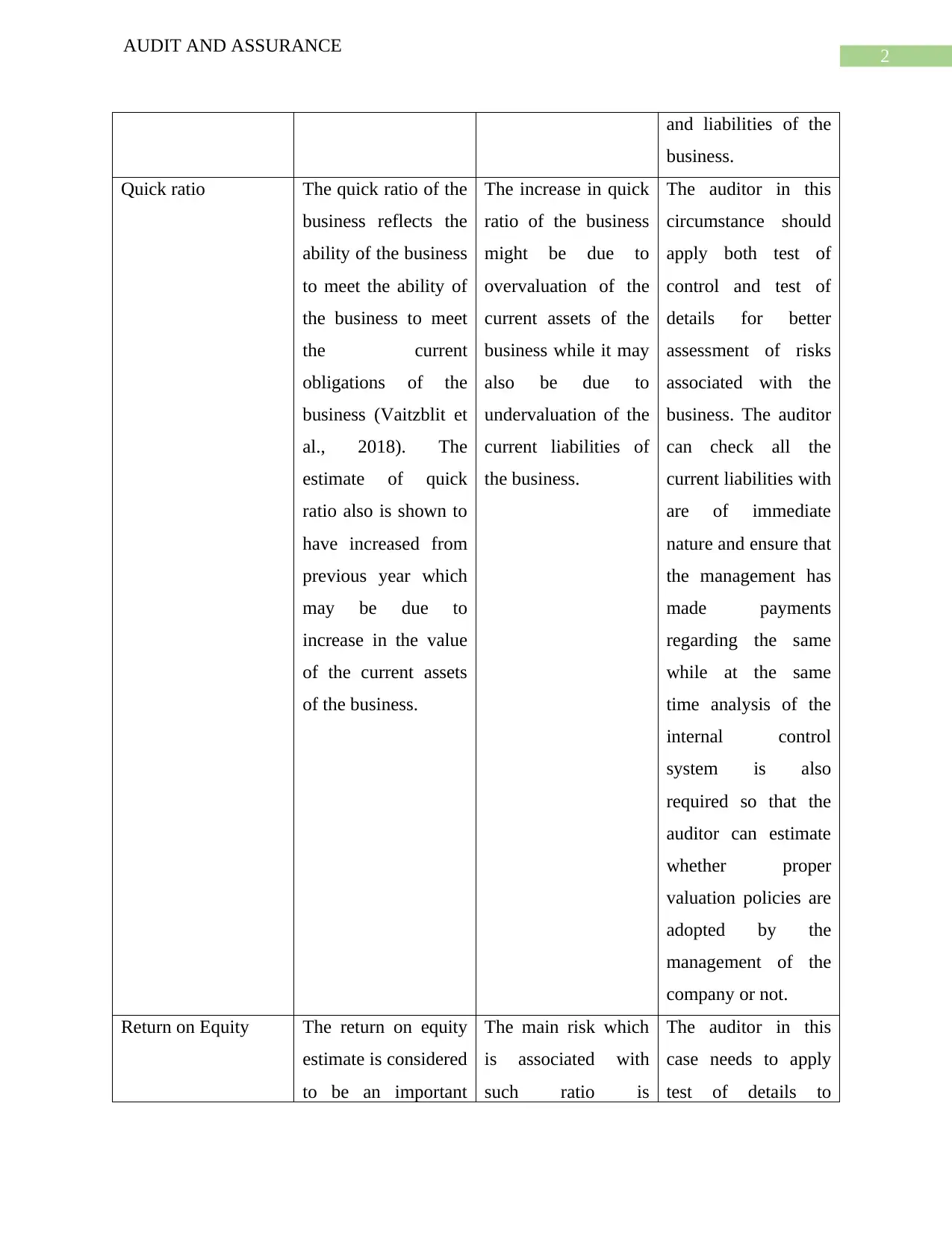
2
AUDIT AND ASSURANCE
and liabilities of the
business.
Quick ratio The quick ratio of the
business reflects the
ability of the business
to meet the ability of
the business to meet
the current
obligations of the
business (Vaitzblit et
al., 2018). The
estimate of quick
ratio also is shown to
have increased from
previous year which
may be due to
increase in the value
of the current assets
of the business.
The increase in quick
ratio of the business
might be due to
overvaluation of the
current assets of the
business while it may
also be due to
undervaluation of the
current liabilities of
the business.
The auditor in this
circumstance should
apply both test of
control and test of
details for better
assessment of risks
associated with the
business. The auditor
can check all the
current liabilities with
are of immediate
nature and ensure that
the management has
made payments
regarding the same
while at the same
time analysis of the
internal control
system is also
required so that the
auditor can estimate
whether proper
valuation policies are
adopted by the
management of the
company or not.
Return on Equity The return on equity
estimate is considered
to be an important
The main risk which
is associated with
such ratio is
The auditor in this
case needs to apply
test of details to
AUDIT AND ASSURANCE
and liabilities of the
business.
Quick ratio The quick ratio of the
business reflects the
ability of the business
to meet the ability of
the business to meet
the current
obligations of the
business (Vaitzblit et
al., 2018). The
estimate of quick
ratio also is shown to
have increased from
previous year which
may be due to
increase in the value
of the current assets
of the business.
The increase in quick
ratio of the business
might be due to
overvaluation of the
current assets of the
business while it may
also be due to
undervaluation of the
current liabilities of
the business.
The auditor in this
circumstance should
apply both test of
control and test of
details for better
assessment of risks
associated with the
business. The auditor
can check all the
current liabilities with
are of immediate
nature and ensure that
the management has
made payments
regarding the same
while at the same
time analysis of the
internal control
system is also
required so that the
auditor can estimate
whether proper
valuation policies are
adopted by the
management of the
company or not.
Return on Equity The return on equity
estimate is considered
to be an important
The main risk which
is associated with
such ratio is
The auditor in this
case needs to apply
test of details to
⊘ This is a preview!⊘
Do you want full access?
Subscribe today to unlock all pages.

Trusted by 1+ million students worldwide
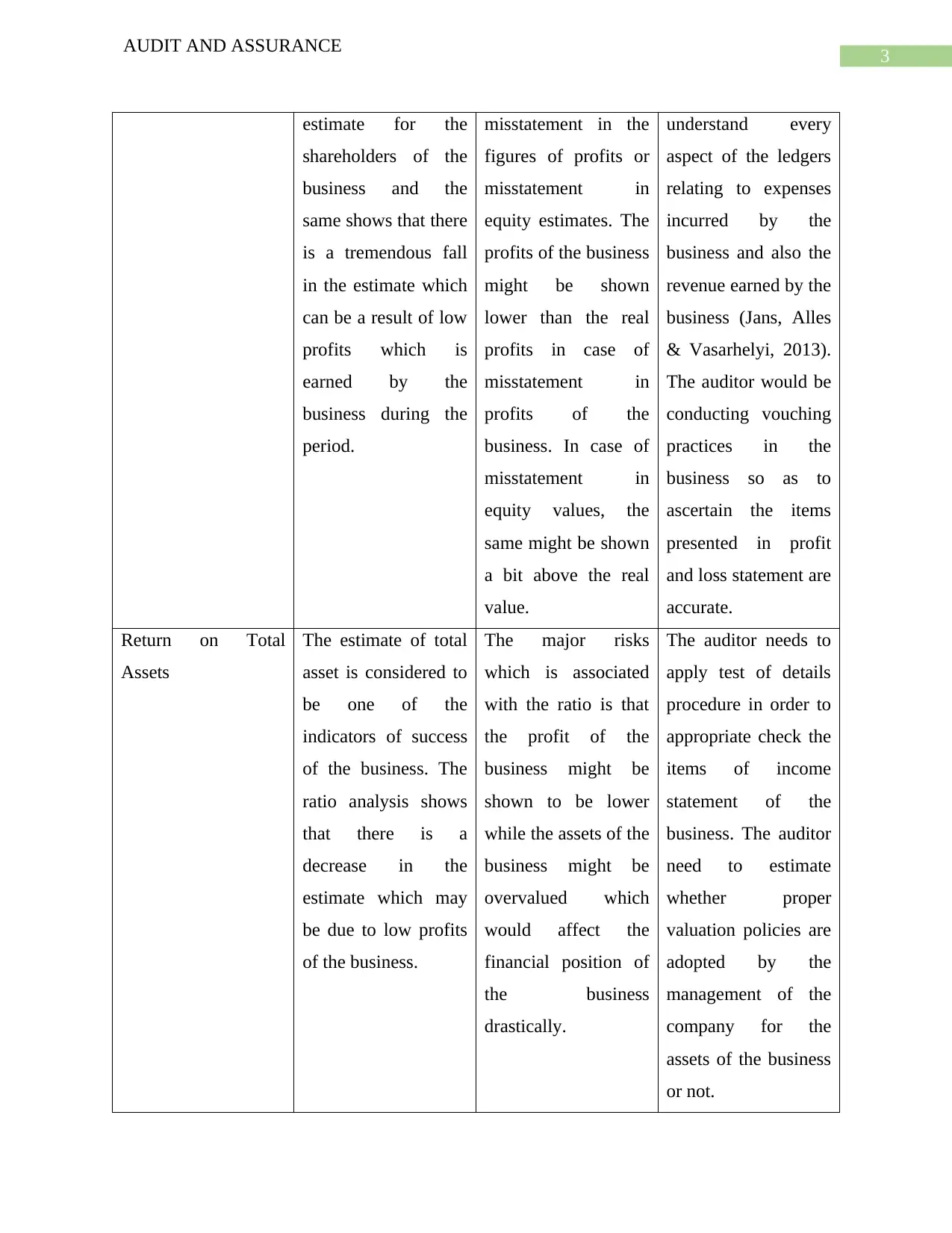
3
AUDIT AND ASSURANCE
estimate for the
shareholders of the
business and the
same shows that there
is a tremendous fall
in the estimate which
can be a result of low
profits which is
earned by the
business during the
period.
misstatement in the
figures of profits or
misstatement in
equity estimates. The
profits of the business
might be shown
lower than the real
profits in case of
misstatement in
profits of the
business. In case of
misstatement in
equity values, the
same might be shown
a bit above the real
value.
understand every
aspect of the ledgers
relating to expenses
incurred by the
business and also the
revenue earned by the
business (Jans, Alles
& Vasarhelyi, 2013).
The auditor would be
conducting vouching
practices in the
business so as to
ascertain the items
presented in profit
and loss statement are
accurate.
Return on Total
Assets
The estimate of total
asset is considered to
be one of the
indicators of success
of the business. The
ratio analysis shows
that there is a
decrease in the
estimate which may
be due to low profits
of the business.
The major risks
which is associated
with the ratio is that
the profit of the
business might be
shown to be lower
while the assets of the
business might be
overvalued which
would affect the
financial position of
the business
drastically.
The auditor needs to
apply test of details
procedure in order to
appropriate check the
items of income
statement of the
business. The auditor
need to estimate
whether proper
valuation policies are
adopted by the
management of the
company for the
assets of the business
or not.
AUDIT AND ASSURANCE
estimate for the
shareholders of the
business and the
same shows that there
is a tremendous fall
in the estimate which
can be a result of low
profits which is
earned by the
business during the
period.
misstatement in the
figures of profits or
misstatement in
equity estimates. The
profits of the business
might be shown
lower than the real
profits in case of
misstatement in
profits of the
business. In case of
misstatement in
equity values, the
same might be shown
a bit above the real
value.
understand every
aspect of the ledgers
relating to expenses
incurred by the
business and also the
revenue earned by the
business (Jans, Alles
& Vasarhelyi, 2013).
The auditor would be
conducting vouching
practices in the
business so as to
ascertain the items
presented in profit
and loss statement are
accurate.
Return on Total
Assets
The estimate of total
asset is considered to
be one of the
indicators of success
of the business. The
ratio analysis shows
that there is a
decrease in the
estimate which may
be due to low profits
of the business.
The major risks
which is associated
with the ratio is that
the profit of the
business might be
shown to be lower
while the assets of the
business might be
overvalued which
would affect the
financial position of
the business
drastically.
The auditor needs to
apply test of details
procedure in order to
appropriate check the
items of income
statement of the
business. The auditor
need to estimate
whether proper
valuation policies are
adopted by the
management of the
company for the
assets of the business
or not.
Paraphrase This Document
Need a fresh take? Get an instant paraphrase of this document with our AI Paraphraser
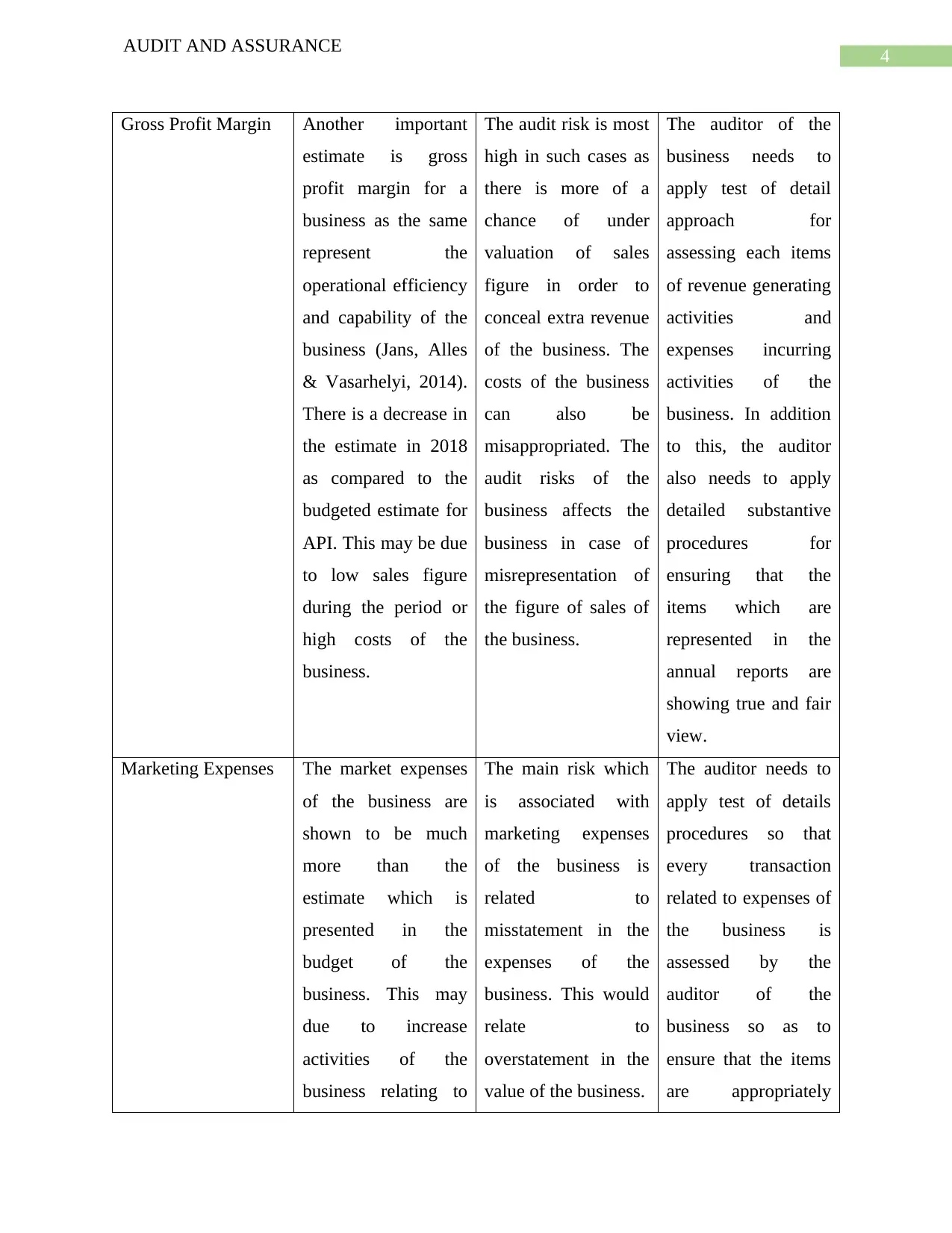
4
AUDIT AND ASSURANCE
Gross Profit Margin Another important
estimate is gross
profit margin for a
business as the same
represent the
operational efficiency
and capability of the
business (Jans, Alles
& Vasarhelyi, 2014).
There is a decrease in
the estimate in 2018
as compared to the
budgeted estimate for
API. This may be due
to low sales figure
during the period or
high costs of the
business.
The audit risk is most
high in such cases as
there is more of a
chance of under
valuation of sales
figure in order to
conceal extra revenue
of the business. The
costs of the business
can also be
misappropriated. The
audit risks of the
business affects the
business in case of
misrepresentation of
the figure of sales of
the business.
The auditor of the
business needs to
apply test of detail
approach for
assessing each items
of revenue generating
activities and
expenses incurring
activities of the
business. In addition
to this, the auditor
also needs to apply
detailed substantive
procedures for
ensuring that the
items which are
represented in the
annual reports are
showing true and fair
view.
Marketing Expenses The market expenses
of the business are
shown to be much
more than the
estimate which is
presented in the
budget of the
business. This may
due to increase
activities of the
business relating to
The main risk which
is associated with
marketing expenses
of the business is
related to
misstatement in the
expenses of the
business. This would
relate to
overstatement in the
value of the business.
The auditor needs to
apply test of details
procedures so that
every transaction
related to expenses of
the business is
assessed by the
auditor of the
business so as to
ensure that the items
are appropriately
AUDIT AND ASSURANCE
Gross Profit Margin Another important
estimate is gross
profit margin for a
business as the same
represent the
operational efficiency
and capability of the
business (Jans, Alles
& Vasarhelyi, 2014).
There is a decrease in
the estimate in 2018
as compared to the
budgeted estimate for
API. This may be due
to low sales figure
during the period or
high costs of the
business.
The audit risk is most
high in such cases as
there is more of a
chance of under
valuation of sales
figure in order to
conceal extra revenue
of the business. The
costs of the business
can also be
misappropriated. The
audit risks of the
business affects the
business in case of
misrepresentation of
the figure of sales of
the business.
The auditor of the
business needs to
apply test of detail
approach for
assessing each items
of revenue generating
activities and
expenses incurring
activities of the
business. In addition
to this, the auditor
also needs to apply
detailed substantive
procedures for
ensuring that the
items which are
represented in the
annual reports are
showing true and fair
view.
Marketing Expenses The market expenses
of the business are
shown to be much
more than the
estimate which is
presented in the
budget of the
business. This may
due to increase
activities of the
business relating to
The main risk which
is associated with
marketing expenses
of the business is
related to
misstatement in the
expenses of the
business. This would
relate to
overstatement in the
value of the business.
The auditor needs to
apply test of details
procedures so that
every transaction
related to expenses of
the business is
assessed by the
auditor of the
business so as to
ensure that the items
are appropriately
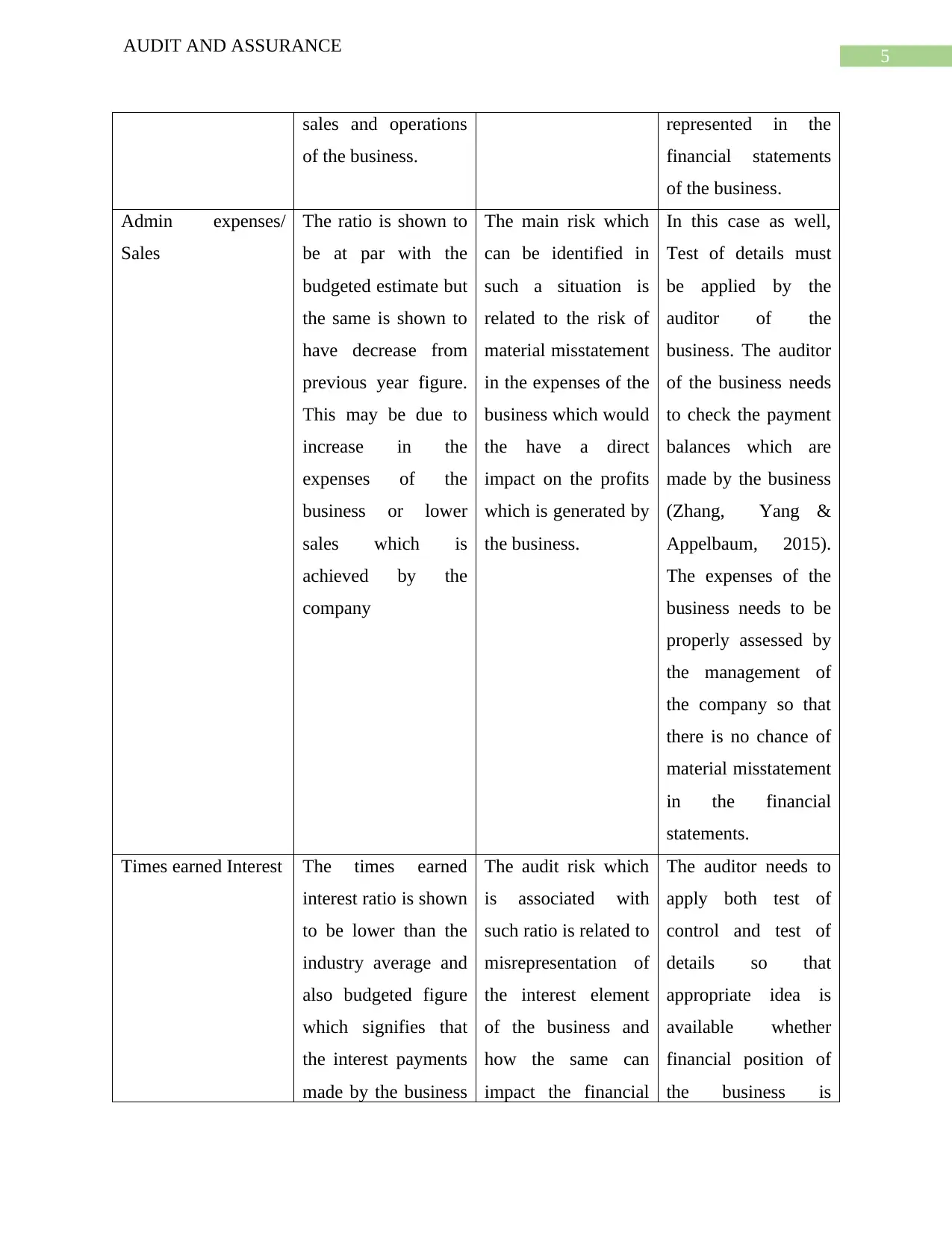
5
AUDIT AND ASSURANCE
sales and operations
of the business.
represented in the
financial statements
of the business.
Admin expenses/
Sales
The ratio is shown to
be at par with the
budgeted estimate but
the same is shown to
have decrease from
previous year figure.
This may be due to
increase in the
expenses of the
business or lower
sales which is
achieved by the
company
The main risk which
can be identified in
such a situation is
related to the risk of
material misstatement
in the expenses of the
business which would
the have a direct
impact on the profits
which is generated by
the business.
In this case as well,
Test of details must
be applied by the
auditor of the
business. The auditor
of the business needs
to check the payment
balances which are
made by the business
(Zhang, Yang &
Appelbaum, 2015).
The expenses of the
business needs to be
properly assessed by
the management of
the company so that
there is no chance of
material misstatement
in the financial
statements.
Times earned Interest The times earned
interest ratio is shown
to be lower than the
industry average and
also budgeted figure
which signifies that
the interest payments
made by the business
The audit risk which
is associated with
such ratio is related to
misrepresentation of
the interest element
of the business and
how the same can
impact the financial
The auditor needs to
apply both test of
control and test of
details so that
appropriate idea is
available whether
financial position of
the business is
AUDIT AND ASSURANCE
sales and operations
of the business.
represented in the
financial statements
of the business.
Admin expenses/
Sales
The ratio is shown to
be at par with the
budgeted estimate but
the same is shown to
have decrease from
previous year figure.
This may be due to
increase in the
expenses of the
business or lower
sales which is
achieved by the
company
The main risk which
can be identified in
such a situation is
related to the risk of
material misstatement
in the expenses of the
business which would
the have a direct
impact on the profits
which is generated by
the business.
In this case as well,
Test of details must
be applied by the
auditor of the
business. The auditor
of the business needs
to check the payment
balances which are
made by the business
(Zhang, Yang &
Appelbaum, 2015).
The expenses of the
business needs to be
properly assessed by
the management of
the company so that
there is no chance of
material misstatement
in the financial
statements.
Times earned Interest The times earned
interest ratio is shown
to be lower than the
industry average and
also budgeted figure
which signifies that
the interest payments
made by the business
The audit risk which
is associated with
such ratio is related to
misrepresentation of
the interest element
of the business and
how the same can
impact the financial
The auditor needs to
apply both test of
control and test of
details so that
appropriate idea is
available whether
financial position of
the business is
⊘ This is a preview!⊘
Do you want full access?
Subscribe today to unlock all pages.

Trusted by 1+ million students worldwide
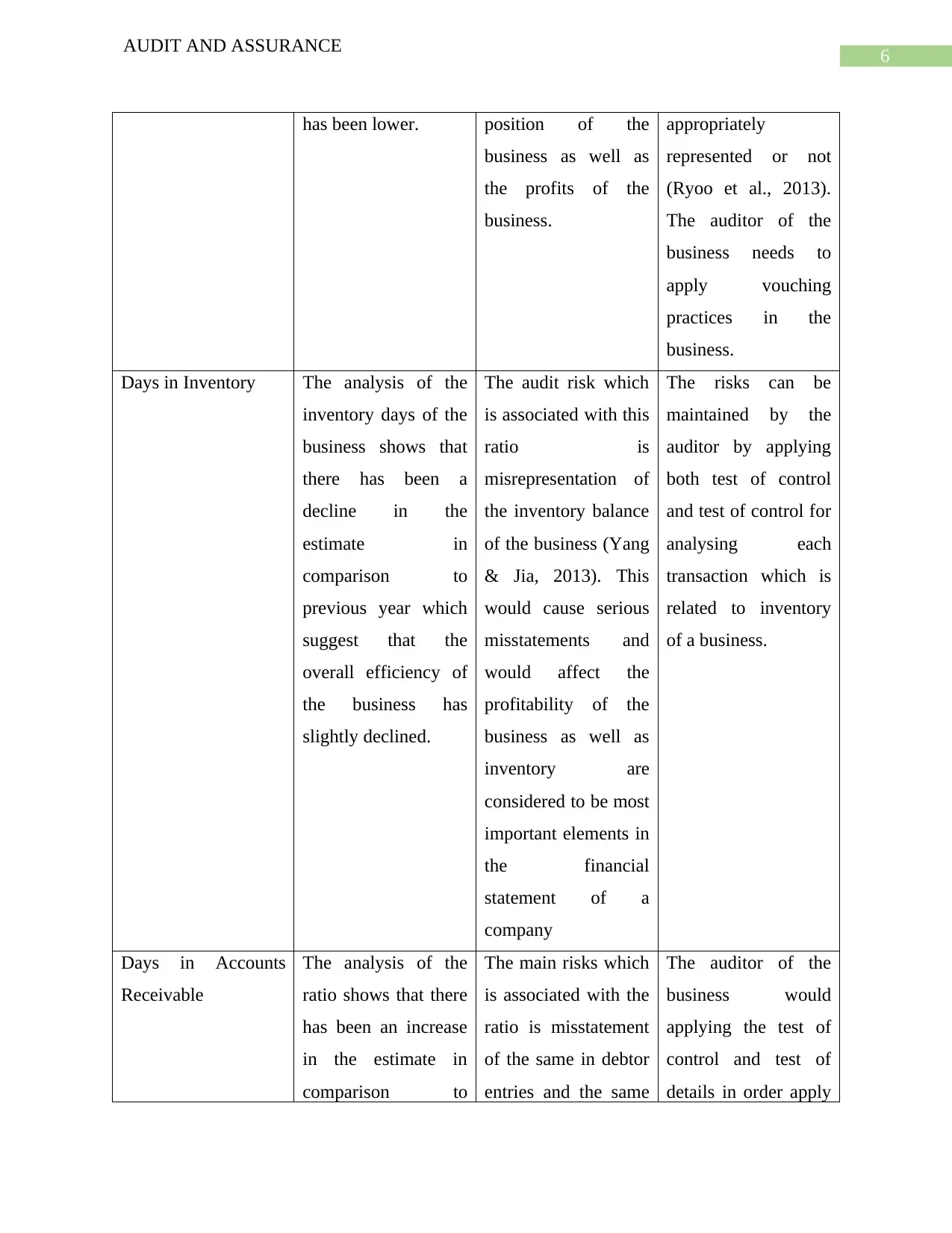
6
AUDIT AND ASSURANCE
has been lower. position of the
business as well as
the profits of the
business.
appropriately
represented or not
(Ryoo et al., 2013).
The auditor of the
business needs to
apply vouching
practices in the
business.
Days in Inventory The analysis of the
inventory days of the
business shows that
there has been a
decline in the
estimate in
comparison to
previous year which
suggest that the
overall efficiency of
the business has
slightly declined.
The audit risk which
is associated with this
ratio is
misrepresentation of
the inventory balance
of the business (Yang
& Jia, 2013). This
would cause serious
misstatements and
would affect the
profitability of the
business as well as
inventory are
considered to be most
important elements in
the financial
statement of a
company
The risks can be
maintained by the
auditor by applying
both test of control
and test of control for
analysing each
transaction which is
related to inventory
of a business.
Days in Accounts
Receivable
The analysis of the
ratio shows that there
has been an increase
in the estimate in
comparison to
The main risks which
is associated with the
ratio is misstatement
of the same in debtor
entries and the same
The auditor of the
business would
applying the test of
control and test of
details in order apply
AUDIT AND ASSURANCE
has been lower. position of the
business as well as
the profits of the
business.
appropriately
represented or not
(Ryoo et al., 2013).
The auditor of the
business needs to
apply vouching
practices in the
business.
Days in Inventory The analysis of the
inventory days of the
business shows that
there has been a
decline in the
estimate in
comparison to
previous year which
suggest that the
overall efficiency of
the business has
slightly declined.
The audit risk which
is associated with this
ratio is
misrepresentation of
the inventory balance
of the business (Yang
& Jia, 2013). This
would cause serious
misstatements and
would affect the
profitability of the
business as well as
inventory are
considered to be most
important elements in
the financial
statement of a
company
The risks can be
maintained by the
auditor by applying
both test of control
and test of control for
analysing each
transaction which is
related to inventory
of a business.
Days in Accounts
Receivable
The analysis of the
ratio shows that there
has been an increase
in the estimate in
comparison to
The main risks which
is associated with the
ratio is misstatement
of the same in debtor
entries and the same
The auditor of the
business would
applying the test of
control and test of
details in order apply
Paraphrase This Document
Need a fresh take? Get an instant paraphrase of this document with our AI Paraphraser
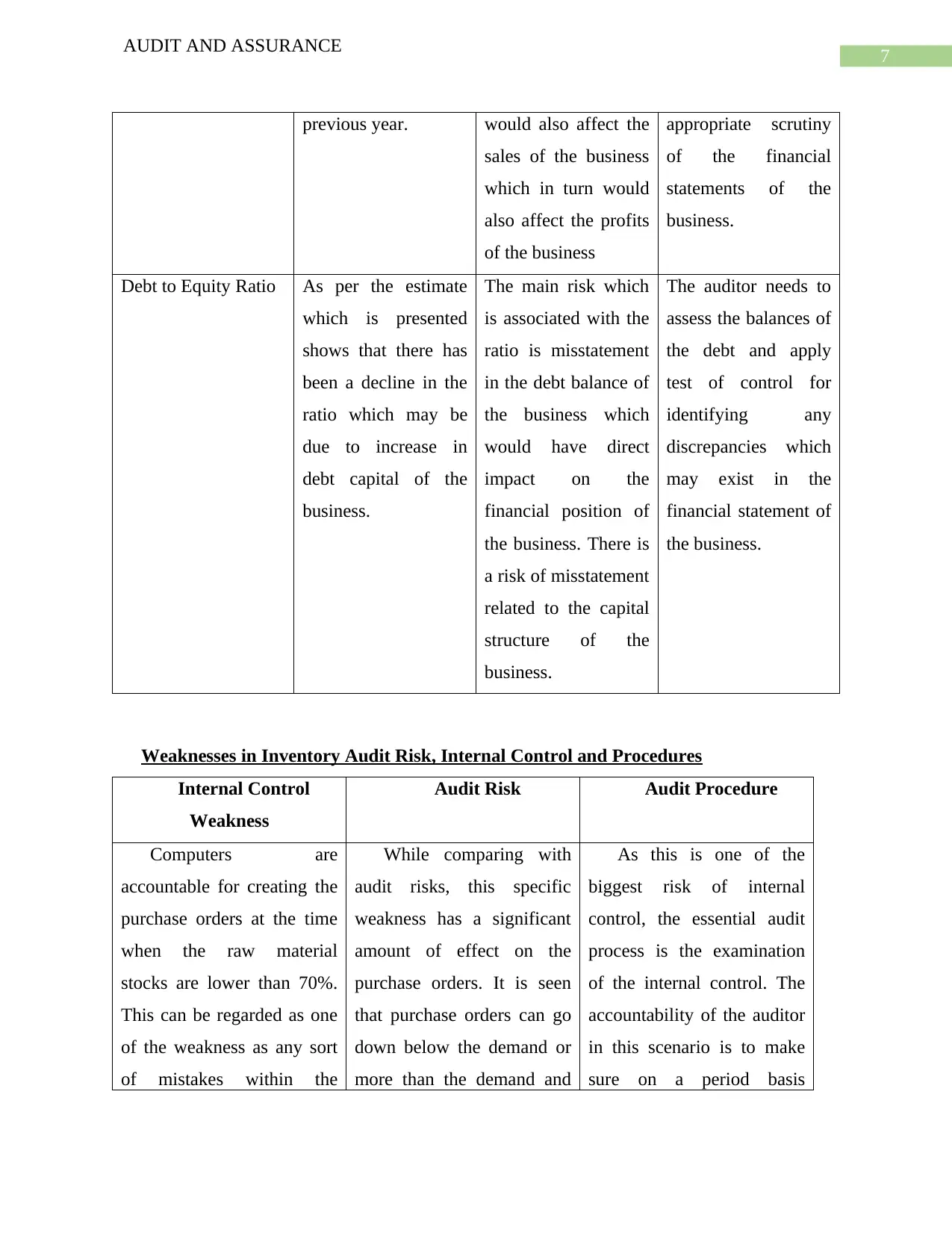
7
AUDIT AND ASSURANCE
previous year. would also affect the
sales of the business
which in turn would
also affect the profits
of the business
appropriate scrutiny
of the financial
statements of the
business.
Debt to Equity Ratio As per the estimate
which is presented
shows that there has
been a decline in the
ratio which may be
due to increase in
debt capital of the
business.
The main risk which
is associated with the
ratio is misstatement
in the debt balance of
the business which
would have direct
impact on the
financial position of
the business. There is
a risk of misstatement
related to the capital
structure of the
business.
The auditor needs to
assess the balances of
the debt and apply
test of control for
identifying any
discrepancies which
may exist in the
financial statement of
the business.
Weaknesses in Inventory Audit Risk, Internal Control and Procedures
Internal Control
Weakness
Audit Risk Audit Procedure
Computers are
accountable for creating the
purchase orders at the time
when the raw material
stocks are lower than 70%.
This can be regarded as one
of the weakness as any sort
of mistakes within the
While comparing with
audit risks, this specific
weakness has a significant
amount of effect on the
purchase orders. It is seen
that purchase orders can go
down below the demand or
more than the demand and
As this is one of the
biggest risk of internal
control, the essential audit
process is the examination
of the internal control. The
accountability of the auditor
in this scenario is to make
sure on a period basis
AUDIT AND ASSURANCE
previous year. would also affect the
sales of the business
which in turn would
also affect the profits
of the business
appropriate scrutiny
of the financial
statements of the
business.
Debt to Equity Ratio As per the estimate
which is presented
shows that there has
been a decline in the
ratio which may be
due to increase in
debt capital of the
business.
The main risk which
is associated with the
ratio is misstatement
in the debt balance of
the business which
would have direct
impact on the
financial position of
the business. There is
a risk of misstatement
related to the capital
structure of the
business.
The auditor needs to
assess the balances of
the debt and apply
test of control for
identifying any
discrepancies which
may exist in the
financial statement of
the business.
Weaknesses in Inventory Audit Risk, Internal Control and Procedures
Internal Control
Weakness
Audit Risk Audit Procedure
Computers are
accountable for creating the
purchase orders at the time
when the raw material
stocks are lower than 70%.
This can be regarded as one
of the weakness as any sort
of mistakes within the
While comparing with
audit risks, this specific
weakness has a significant
amount of effect on the
purchase orders. It is seen
that purchase orders can go
down below the demand or
more than the demand and
As this is one of the
biggest risk of internal
control, the essential audit
process is the examination
of the internal control. The
accountability of the auditor
in this scenario is to make
sure on a period basis
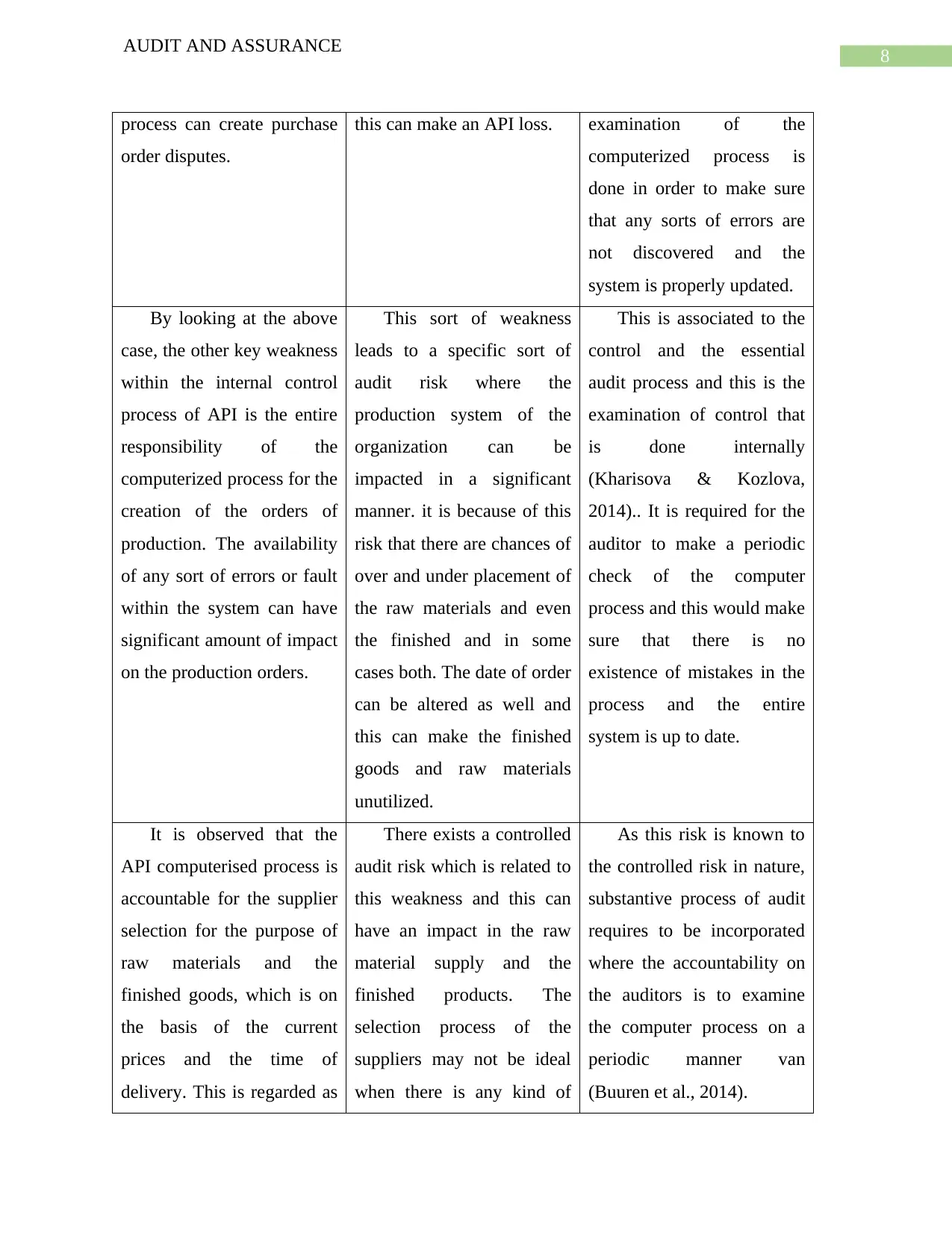
8
AUDIT AND ASSURANCE
process can create purchase
order disputes.
this can make an API loss. examination of the
computerized process is
done in order to make sure
that any sorts of errors are
not discovered and the
system is properly updated.
By looking at the above
case, the other key weakness
within the internal control
process of API is the entire
responsibility of the
computerized process for the
creation of the orders of
production. The availability
of any sort of errors or fault
within the system can have
significant amount of impact
on the production orders.
This sort of weakness
leads to a specific sort of
audit risk where the
production system of the
organization can be
impacted in a significant
manner. it is because of this
risk that there are chances of
over and under placement of
the raw materials and even
the finished and in some
cases both. The date of order
can be altered as well and
this can make the finished
goods and raw materials
unutilized.
This is associated to the
control and the essential
audit process and this is the
examination of control that
is done internally
(Kharisova & Kozlova,
2014).. It is required for the
auditor to make a periodic
check of the computer
process and this would make
sure that there is no
existence of mistakes in the
process and the entire
system is up to date.
It is observed that the
API computerised process is
accountable for the supplier
selection for the purpose of
raw materials and the
finished goods, which is on
the basis of the current
prices and the time of
delivery. This is regarded as
There exists a controlled
audit risk which is related to
this weakness and this can
have an impact in the raw
material supply and the
finished products. The
selection process of the
suppliers may not be ideal
when there is any kind of
As this risk is known to
the controlled risk in nature,
substantive process of audit
requires to be incorporated
where the accountability on
the auditors is to examine
the computer process on a
periodic manner van
(Buuren et al., 2014).
AUDIT AND ASSURANCE
process can create purchase
order disputes.
this can make an API loss. examination of the
computerized process is
done in order to make sure
that any sorts of errors are
not discovered and the
system is properly updated.
By looking at the above
case, the other key weakness
within the internal control
process of API is the entire
responsibility of the
computerized process for the
creation of the orders of
production. The availability
of any sort of errors or fault
within the system can have
significant amount of impact
on the production orders.
This sort of weakness
leads to a specific sort of
audit risk where the
production system of the
organization can be
impacted in a significant
manner. it is because of this
risk that there are chances of
over and under placement of
the raw materials and even
the finished and in some
cases both. The date of order
can be altered as well and
this can make the finished
goods and raw materials
unutilized.
This is associated to the
control and the essential
audit process and this is the
examination of control that
is done internally
(Kharisova & Kozlova,
2014).. It is required for the
auditor to make a periodic
check of the computer
process and this would make
sure that there is no
existence of mistakes in the
process and the entire
system is up to date.
It is observed that the
API computerised process is
accountable for the supplier
selection for the purpose of
raw materials and the
finished goods, which is on
the basis of the current
prices and the time of
delivery. This is regarded as
There exists a controlled
audit risk which is related to
this weakness and this can
have an impact in the raw
material supply and the
finished products. The
selection process of the
suppliers may not be ideal
when there is any kind of
As this risk is known to
the controlled risk in nature,
substantive process of audit
requires to be incorporated
where the accountability on
the auditors is to examine
the computer process on a
periodic manner van
(Buuren et al., 2014).
⊘ This is a preview!⊘
Do you want full access?
Subscribe today to unlock all pages.

Trusted by 1+ million students worldwide

9
AUDIT AND ASSURANCE
a weakness as the existence
of any glitch and errors
within the computer process
can make the selection
process of the suppliers full
of error.
errors.
One of the major
weaknesses is that a single
staff member has access to
update the master file and is
also responsible of copying
GRN and purchase orders.
In such a case audit risk
can develop as the clerk can
easily manipulate the master
file and thereby cause
material misstatement to
financial records.
The auditor of the business
needs to appropriately check
the transactions which are
covered in the master file
along with different records
of the business. The auditor
needs apply compliance
procedures to check the
internal control of the
busness.
The production controller
has access to master file
password and he is also
responsible for printing of
production orders and can
also amend the master file.
This is a weakness as the
same authority can be used
for manipulating the
production records
This situation also leads to
audit risks as the same
would result in misstatement
of production and wrong
purchase orders which
would adversely affect the
revenues of the business.
The auditor in such a can
check the production records
and purchase invoices and
purchase registers for
ascertaining if there are any
discrepancies. The auditor
also can suggest to the
management of API to
segregate the duties of the
employee appropriately.
The responsibility of order
printing and GRN printing
of raw material purchase and
finished good purchased by
the store staff which is a
The audit risk associated
with this is there can be
manipulation in store
records of raw materials and
finished goods which would
In this case, the auditor can
make suggestions to the
management of the company
for segregating the duties so
as to maintain transparency
AUDIT AND ASSURANCE
a weakness as the existence
of any glitch and errors
within the computer process
can make the selection
process of the suppliers full
of error.
errors.
One of the major
weaknesses is that a single
staff member has access to
update the master file and is
also responsible of copying
GRN and purchase orders.
In such a case audit risk
can develop as the clerk can
easily manipulate the master
file and thereby cause
material misstatement to
financial records.
The auditor of the business
needs to appropriately check
the transactions which are
covered in the master file
along with different records
of the business. The auditor
needs apply compliance
procedures to check the
internal control of the
busness.
The production controller
has access to master file
password and he is also
responsible for printing of
production orders and can
also amend the master file.
This is a weakness as the
same authority can be used
for manipulating the
production records
This situation also leads to
audit risks as the same
would result in misstatement
of production and wrong
purchase orders which
would adversely affect the
revenues of the business.
The auditor in such a can
check the production records
and purchase invoices and
purchase registers for
ascertaining if there are any
discrepancies. The auditor
also can suggest to the
management of API to
segregate the duties of the
employee appropriately.
The responsibility of order
printing and GRN printing
of raw material purchase and
finished good purchased by
the store staff which is a
The audit risk associated
with this is there can be
manipulation in store
records of raw materials and
finished goods which would
In this case, the auditor can
make suggestions to the
management of the company
for segregating the duties so
as to maintain transparency
Paraphrase This Document
Need a fresh take? Get an instant paraphrase of this document with our AI Paraphraser
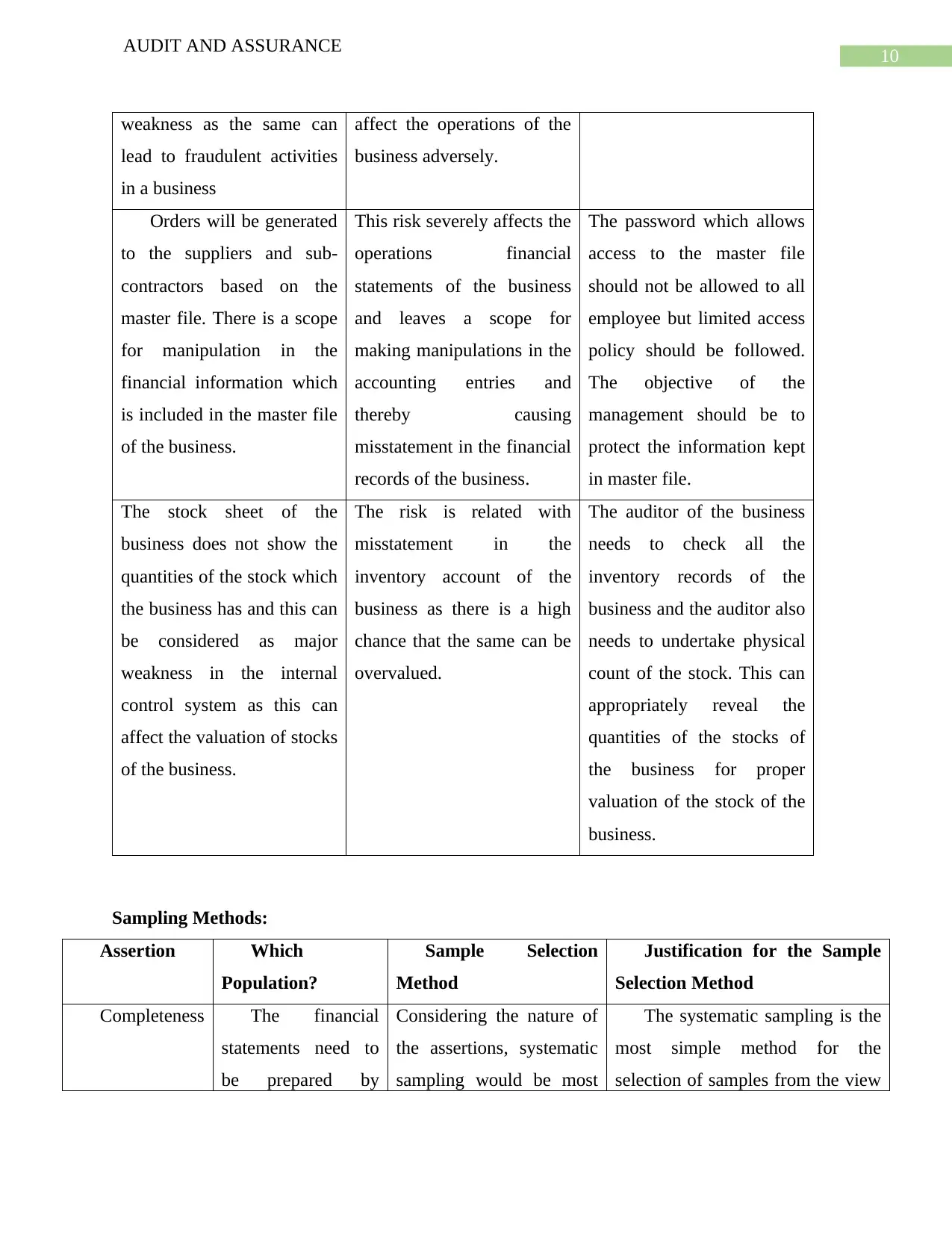
10
AUDIT AND ASSURANCE
weakness as the same can
lead to fraudulent activities
in a business
affect the operations of the
business adversely.
Orders will be generated
to the suppliers and sub-
contractors based on the
master file. There is a scope
for manipulation in the
financial information which
is included in the master file
of the business.
This risk severely affects the
operations financial
statements of the business
and leaves a scope for
making manipulations in the
accounting entries and
thereby causing
misstatement in the financial
records of the business.
The password which allows
access to the master file
should not be allowed to all
employee but limited access
policy should be followed.
The objective of the
management should be to
protect the information kept
in master file.
The stock sheet of the
business does not show the
quantities of the stock which
the business has and this can
be considered as major
weakness in the internal
control system as this can
affect the valuation of stocks
of the business.
The risk is related with
misstatement in the
inventory account of the
business as there is a high
chance that the same can be
overvalued.
The auditor of the business
needs to check all the
inventory records of the
business and the auditor also
needs to undertake physical
count of the stock. This can
appropriately reveal the
quantities of the stocks of
the business for proper
valuation of the stock of the
business.
Sampling Methods:
Assertion Which
Population?
Sample Selection
Method
Justification for the Sample
Selection Method
Completeness The financial
statements need to
be prepared by
Considering the nature of
the assertions, systematic
sampling would be most
The systematic sampling is the
most simple method for the
selection of samples from the view
AUDIT AND ASSURANCE
weakness as the same can
lead to fraudulent activities
in a business
affect the operations of the
business adversely.
Orders will be generated
to the suppliers and sub-
contractors based on the
master file. There is a scope
for manipulation in the
financial information which
is included in the master file
of the business.
This risk severely affects the
operations financial
statements of the business
and leaves a scope for
making manipulations in the
accounting entries and
thereby causing
misstatement in the financial
records of the business.
The password which allows
access to the master file
should not be allowed to all
employee but limited access
policy should be followed.
The objective of the
management should be to
protect the information kept
in master file.
The stock sheet of the
business does not show the
quantities of the stock which
the business has and this can
be considered as major
weakness in the internal
control system as this can
affect the valuation of stocks
of the business.
The risk is related with
misstatement in the
inventory account of the
business as there is a high
chance that the same can be
overvalued.
The auditor of the business
needs to check all the
inventory records of the
business and the auditor also
needs to undertake physical
count of the stock. This can
appropriately reveal the
quantities of the stocks of
the business for proper
valuation of the stock of the
business.
Sampling Methods:
Assertion Which
Population?
Sample Selection
Method
Justification for the Sample
Selection Method
Completeness The financial
statements need to
be prepared by
Considering the nature of
the assertions, systematic
sampling would be most
The systematic sampling is the
most simple method for the
selection of samples from the view
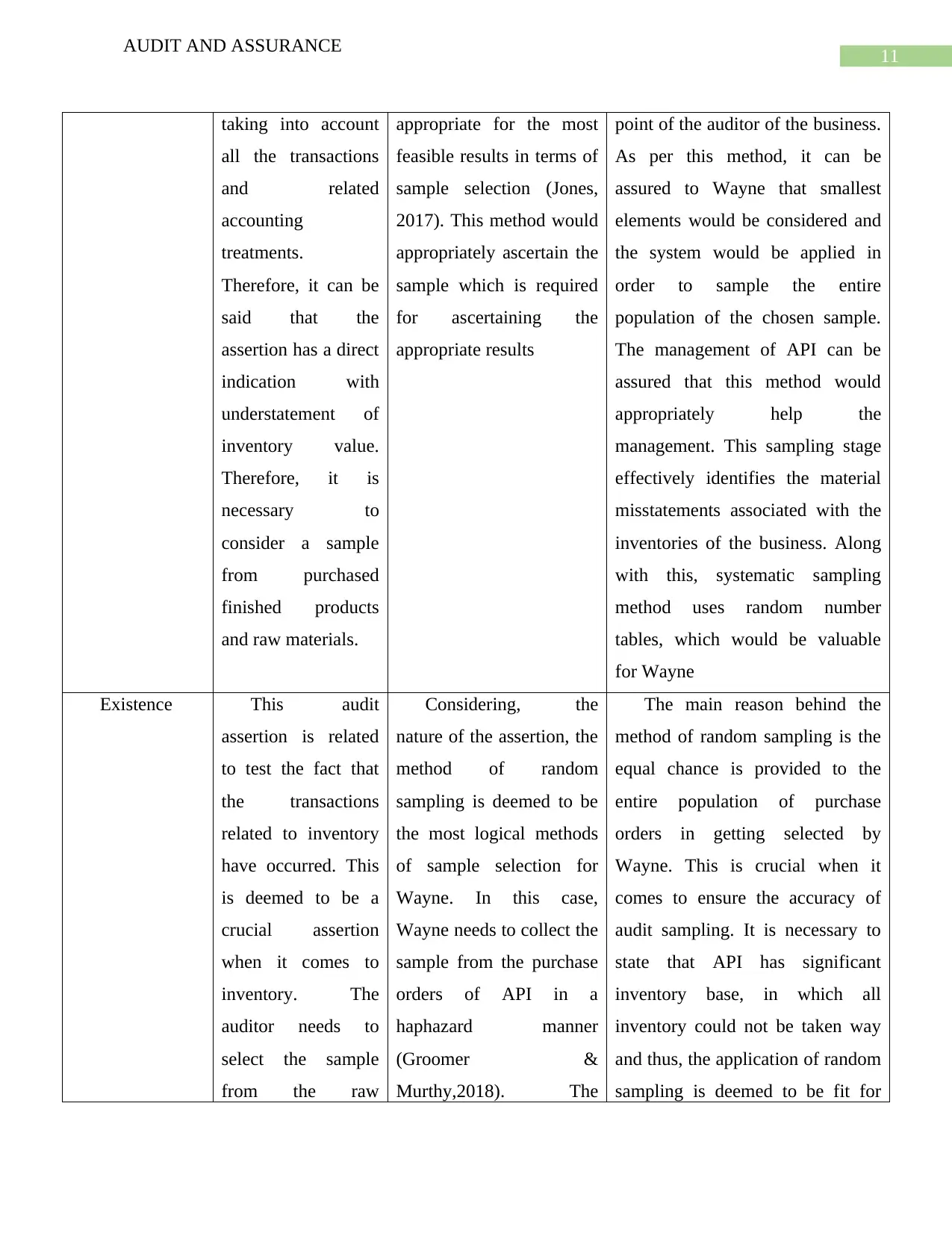
11
AUDIT AND ASSURANCE
taking into account
all the transactions
and related
accounting
treatments.
Therefore, it can be
said that the
assertion has a direct
indication with
understatement of
inventory value.
Therefore, it is
necessary to
consider a sample
from purchased
finished products
and raw materials.
appropriate for the most
feasible results in terms of
sample selection (Jones,
2017). This method would
appropriately ascertain the
sample which is required
for ascertaining the
appropriate results
point of the auditor of the business.
As per this method, it can be
assured to Wayne that smallest
elements would be considered and
the system would be applied in
order to sample the entire
population of the chosen sample.
The management of API can be
assured that this method would
appropriately help the
management. This sampling stage
effectively identifies the material
misstatements associated with the
inventories of the business. Along
with this, systematic sampling
method uses random number
tables, which would be valuable
for Wayne
Existence This audit
assertion is related
to test the fact that
the transactions
related to inventory
have occurred. This
is deemed to be a
crucial assertion
when it comes to
inventory. The
auditor needs to
select the sample
from the raw
Considering, the
nature of the assertion, the
method of random
sampling is deemed to be
the most logical methods
of sample selection for
Wayne. In this case,
Wayne needs to collect the
sample from the purchase
orders of API in a
haphazard manner
(Groomer &
Murthy,2018). The
The main reason behind the
method of random sampling is the
equal chance is provided to the
entire population of purchase
orders in getting selected by
Wayne. This is crucial when it
comes to ensure the accuracy of
audit sampling. It is necessary to
state that API has significant
inventory base, in which all
inventory could not be taken way
and thus, the application of random
sampling is deemed to be fit for
AUDIT AND ASSURANCE
taking into account
all the transactions
and related
accounting
treatments.
Therefore, it can be
said that the
assertion has a direct
indication with
understatement of
inventory value.
Therefore, it is
necessary to
consider a sample
from purchased
finished products
and raw materials.
appropriate for the most
feasible results in terms of
sample selection (Jones,
2017). This method would
appropriately ascertain the
sample which is required
for ascertaining the
appropriate results
point of the auditor of the business.
As per this method, it can be
assured to Wayne that smallest
elements would be considered and
the system would be applied in
order to sample the entire
population of the chosen sample.
The management of API can be
assured that this method would
appropriately help the
management. This sampling stage
effectively identifies the material
misstatements associated with the
inventories of the business. Along
with this, systematic sampling
method uses random number
tables, which would be valuable
for Wayne
Existence This audit
assertion is related
to test the fact that
the transactions
related to inventory
have occurred. This
is deemed to be a
crucial assertion
when it comes to
inventory. The
auditor needs to
select the sample
from the raw
Considering, the
nature of the assertion, the
method of random
sampling is deemed to be
the most logical methods
of sample selection for
Wayne. In this case,
Wayne needs to collect the
sample from the purchase
orders of API in a
haphazard manner
(Groomer &
Murthy,2018). The
The main reason behind the
method of random sampling is the
equal chance is provided to the
entire population of purchase
orders in getting selected by
Wayne. This is crucial when it
comes to ensure the accuracy of
audit sampling. It is necessary to
state that API has significant
inventory base, in which all
inventory could not be taken way
and thus, the application of random
sampling is deemed to be fit for
⊘ This is a preview!⊘
Do you want full access?
Subscribe today to unlock all pages.

Trusted by 1+ million students worldwide
1 out of 15
Related Documents
Your All-in-One AI-Powered Toolkit for Academic Success.
+13062052269
info@desklib.com
Available 24*7 on WhatsApp / Email
![[object Object]](/_next/static/media/star-bottom.7253800d.svg)
Unlock your academic potential
Copyright © 2020–2025 A2Z Services. All Rights Reserved. Developed and managed by ZUCOL.





